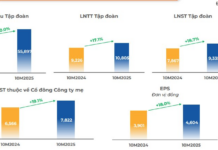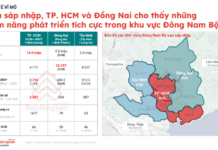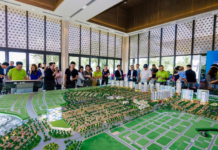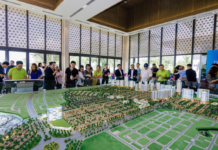Nestled deep within Alley 408 on Nguyen Thi Minh Khai Street, Ward Ban Co, tiny houses measuring just 4-6 square meters have stood for decades, resembling miniature boxes dwarfed by the modern cityscape.
This is a snapshot of urban life, where many still live, work, raise children, and nurture hopes within spaces barely large enough to stretch an arm.
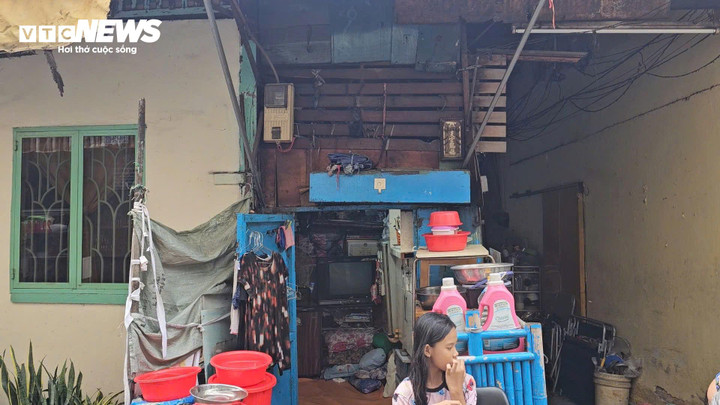
A 4-square-meter home viewed from the outside.
Incredibly Compact
The cramped feeling is immediately apparent upon entering these micro-homes. Doorways are so low that adults must stoop to pass through.
Mrs. Kha Tu Ngoc (70, Ward Ban Co, Ho Chi Minh City) has lived in her 4-square-meter home since 1989. The space barely accommodates essential items. It’s so tight that turning around is difficult, and every step risks knocking into furniture or stacked belongings.
An old refrigerator serves as a “multi-purpose cabinet,” storing books, clothes, raincoats, and shoes for Mrs. Ngoc’s granddaughter, Nguyen Duong Bao My, a 7th-grade student.
My must bend her head while moving around, as standing upright means hitting the cabinet or overhead shelf. Even sleeping requires curling up due to the limited space.
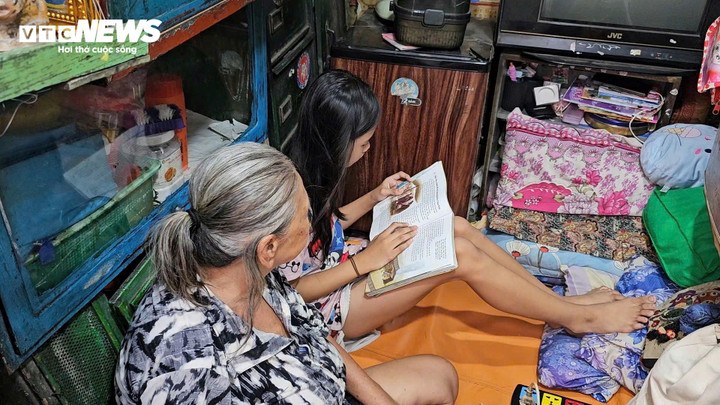
Eating, sleeping, and daily activities are confined to this tiny space.
Daily challenges are familiar to the grandmother and granddaughter, from bending down and sidestepping to moving lightly to avoid knocking things over.
“Many wonder how we manage in such a small space, even smaller than a typical rental room. But I’m used to it. We adapt by folding and unfolding items, keeping everything compact yet comfortable,” says Mrs. Ngoc.
Cooking requires moving the charcoal stove to the alley. Food must cool before being stored on the table’s edge. The rice cooker sits on the sleeping area due to lack of space.
Laundry is done at a nearby drain, using water piped from a nearby temple, which saves costs but introduces inconveniences.
Personal hygiene is a major concern. Bathing and using the toilet require a 500-meter trip to the Chuoi Garden Market’s public facilities, costing 5,000 VND per visit.
At night, sudden stomachaches mean taking medication instead of venturing out.

Walls are pieced together from makeshift boards.
Mrs. Ngoc earns 80,000-100,000 VND daily from odd jobs around the market, making a larger home unattainable.
This income covers all expenses, including 5,000 VND per person for bathing or using the toilet, totaling over 10,000 VND daily for basic needs.
Each evening, after My finishes studying and clears the table, the two lay down a mat for sleep. There’s no concept of separate beds or spaces; all activities occur within the same cramped area, rotating daily.
Their sleeping space is less than a meter wide, allowing only side-sleeping with minimal movement. On hot days, heat from the roof and surroundings makes the space stifling, as air circulation is nearly impossible in such a confined area.
5 People in 6 Square Meters
Next to Mrs. Ngoc’s home lives another family. Mrs. Phan Thi Quang’s (71) 6-square-meter house has been home to five family members for over 30 years. Despite having seven family members, five currently reside in this cramped space.
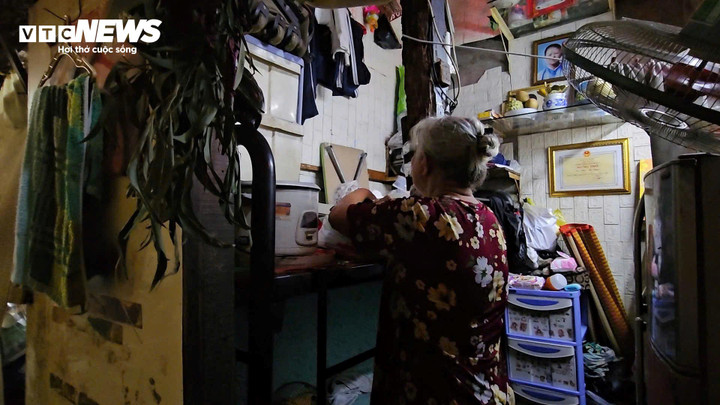
Inside Mrs. Quang’s tiny home.
Space is so limited that there isn’t enough room for everyone to sleep. Each night, Mrs. Quang sleeps outside, near the alley entrance. She sets up a folding bed against the wall, her nightly resting place for years.
Like others here, her home lacks a bathroom. Bathing and toileting require paid visits, 5,000 VND per person.
“At night, we use a chamber pot. Sometimes, stomachaches mean taking medicine. Once, in an emergency, I had to ask a neighbor for help. It’s inconvenient, but there’s no other choice,” shares Mrs. Quang.
In the same alley, Be Hai’s family lives in a similarly cramped space. Be Hai, a noodle vendor, supports her mother and three young children, the oldest in first grade. Her income is unstable, while her mother sells lottery tickets to contribute.
Arranging sleeping spaces is a challenge. Be Hai shares a bed with two children; the third sleeps with her grandmother. The already tight space feels more suffocating with belongings stacked high against the walls.

Space is just enough for a single bed.
All cooking is done in the alley, using a small gas stove against the wall. Family meals are served on the shared pathway in front of the house.
In the heart of one of the country’s most developed cities, where land costs hundreds of millions per square meter, these tiny homes and their residents endure significant deprivation.
These homes aren’t just small in size; they limit options for the urban poor. Cramped spaces, low incomes, and rising living costs make relocation or lifestyle changes nearly impossible.


















